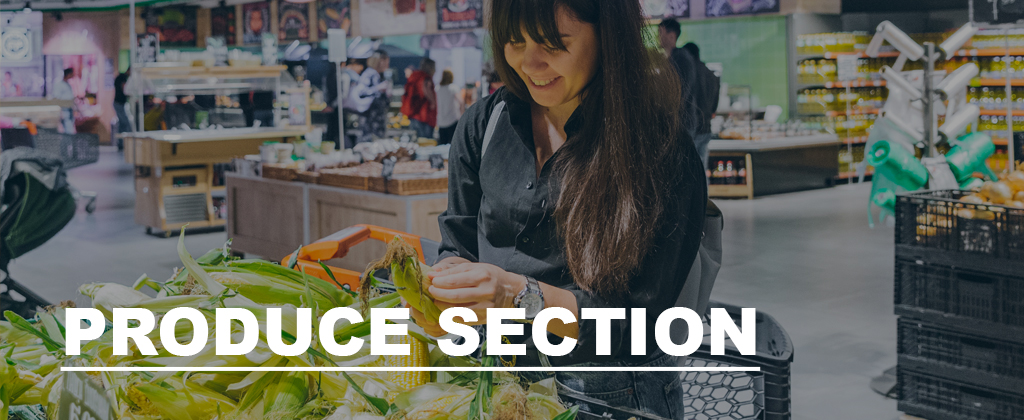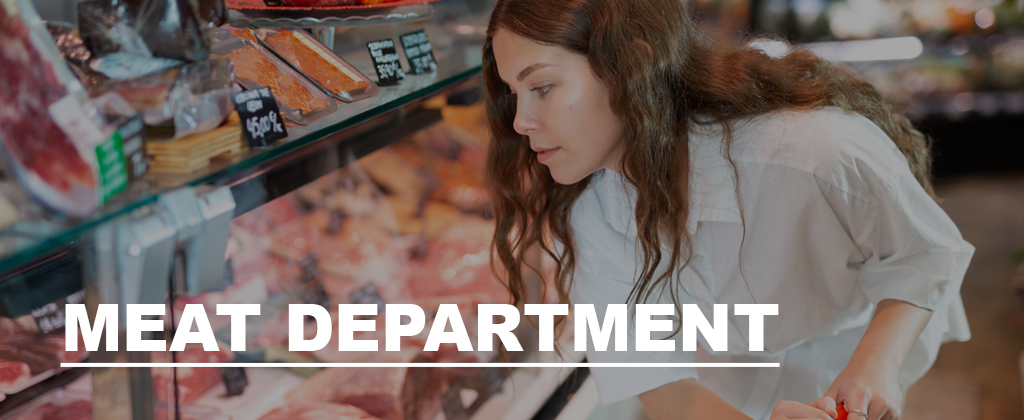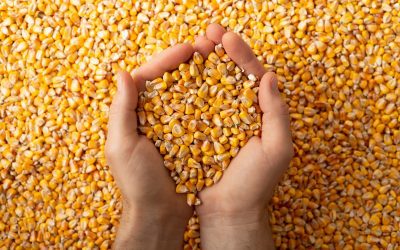Indiana Grown Grocery Shopping Guide
Posted: July 17, 2023
Category:
News
If you are responsible for the grocery shopping in your household, you know how many decisions are required in an average shopping trip. You want to make choices that are healthy for your family while staying within your budget. You may even make your purchasing decisions based on what’s the most sustainable for the environment.
The next time you step into the store, use this guide to see which items going into your cart are Indiana grown. You might learn some surprising facts along the way! You can rest easy knowing many of the foods you purchase on a regular basis are locally produced, and the farmers behind them care about what their families are eating as much as you care about yours.

The journey through the supermarket begins in the produce department, where you take care to choose fruits and vegetables that your family enjoys and will help you make healthy meals. Indiana ranks in the top 5 for production of several fruits and veggies.
The Versatility of Corn
You’ve probably bought corn at one time or another in the grocery store – either in a can or on the cob. You may associate it with the cornfields you see in the rural areas of Indiana, but 98% of the fields you see are actually dent corn. While this type of corn can be made into some corn-based food products like tortilla chips, it is primarily used to feed animals and goes into products like fabrics, carpet, plastics and ethanol fuel.
Sweet corn is what most of us are familiar with seeing on our dinner tables. Out of all the corn grown in Indiana, sweet corn makes up just 1%. So what’s the difference? Seed and field corn are given time to mature and dry out in the field so they are in good condition to be harvested and stored in bins or sold. Sweet corn is harvested when the ear is immature, which gives the kernels a soft, milky texture.
Fruit of the Loam
While you may immediately think of corn when you think of Indiana, many other types of produce are grown in Indiana too. Another summer staple, watermelon, is grown here – around 7,500 acres of it. An acre is about the size of a football field. That’s a lot of watermelon! And what’s fall without pumpkin-flavored everything? Indiana is the second highest pumpkin producing state in the U.S. In 2021, Indiana farmers grew 181 million pounds of pumpkin.
The type of crops that are grown in a particular area depends on its climate conditions and soil types. Indiana has a moderate climate, and its soil contains a lot of loam – the rich, black soil that is common in midwestern states and creates a good growing environment for crops. Farmers use practices on their farms to protect that soil and make sure it stays in the field where it needs to be so it can continue to be used year after year. One big thing farmers do to protect the soil is no-till or conservation tillage. This means, instead of plowing the soil so it’s completely black after harvest, they leave all or some of the crop residue on the field to hold the soil in place and supply it with nutrients.
No matter the crop, Indiana farmers take care to make sure they are preserving the land and growing the most product with as few resources as possible to help feed the world and care for our planet.

Once you’re finished in the produce section, you may head to the bakery. The cookies, cakes, breads and other delicious treats in this section are made using Indiana crops.
Vegetable Oil’s True Identity
The decadent brownies or cake you’re eyeing likely has soybean oil in it. Even when you bake those goodies at home, you’re likely using soybean oil, even if you don’t know it! The bottles labeled “vegetable oil” on the shelves usually contain all or mostly soybean oil. Vegetable oil has many different cooking and baking applications because it adds moisture and a rich and tender element to recipes and has a neutral flavor.
Soybean oil is the most widely used vegetable oil, accounting for more than half of all of the vegetable oil used in the U.S.
Flour Power
Corn and soybean meal is also ground into flour that is used in many different baking applications. Soy flour is often added to baked goods, as it adds volume and softness. It contains lecithin, which acts as an emulsifier and thickens batters and dough. Soy flour is often used in cake and yeast donuts for these reasons as well. Corn starch is a common ingredient used in cooking and baking and is often used as a thickening agent. However, it can also be added to cakes, cookies, pie crusts and more to create a crumbly, tender texture.
What about Wheat?
Of course, wheat is commonly found in baked goods, and Indiana is no stranger to this crop, as it ranks as the state’s number three crop. Unlike a lot of crops that are planted in the spring or summer, winter wheat is common in Indiana. Flour made from red winter wheat is found in many different types of bakery staples. Planted in the fall, winter wheat goes dormant through the winter, where it provides cover for the soil, so it won’t be lost to wind or water erosion. Some farmers harvest winter wheat as a cash crop, or a crop that is sold for a profit, but others use winter wheat only as a cover crop, or a crop that is used to protect the soil when cash crops are not in the ground.

Next up is the dairy section, where you’ll find a selection of eggs, milk, cheese and other dairy and refrigerated products. Corn and soybean production plays a role here too as these crops are used for feeding animals like cows and chickens, who use that food as fuel to produce milk, butter and eggs, staples of the American diet. Having the proper balance of nutrients in their feed helps ensure that the cows and chickens are healthy and able to produce
the best quality milk and eggs possible.
A Short Trek From the Farm
Although it may not be indicated on the carton or label, most of the milk and eggs in the grocery store come from local cows and chickens because of the short shelf life of these products. Milk typically arrives in the cooler of your local grocery store around 48 hours after it is milked, and eggs make it to the store a few days after being laid. So next time you drink a glass of milk or cook up some eggs, remember that they likely came from your local Indiana cows and chickens.
Coffee With a Side of Soy
Next to the milk in the dairy section you’ll find coffee creamer, often in a range of delicious flavors. If you’re a fan of Coffee-Mate®, you may have Indiana farmers to thank for sweetening your morning cup of joe. Anderson, Indiana is home to a Nestle® plant that also uses high oleic soybean oil in its Coffee-Mate® liquid products.
High oleic soybean oil comes from high oleic soybeans, many of which are grown in Indiana. High oleic soybean oil is lower in saturated fat, which is known as an “unhealthy” type of fat, and has three times the amount of monounsaturated fatty acids, which are better for you and your family. The Nestle® plant uses milk from Indiana cows to produce ready-to-drink products like Nesquik® and Boost® nutritional drinks.

As you head into the meat department, the first connection to agriculture that comes to mind is probably livestock farming, but corn and soy play a big role in animal agriculture as well. One of the major uses for corn and soybeans is animal feed – approximately 40% of corn and 70% of soybeans – which is turned into energy for the cows, chickens and pigs that create energy for us in the beef, chicken and pork we eat.
Approximately 40% of corn and 70% of soybeans grown in the U.S. are used to feed livestock.
All of the Protein, None of the Meat
Additionally, plant-based meat substitutes are becoming increasingly popular for those who choose not to eat meat. These meat substitutes are being used to mimic the taste and flavor of beef, chicken and pork in popular foods found in grocery stores and chain fast food restaurants. Because soy is a complete protein source, meaning it contains all nine essential amino acids, it makes an excellent candidate for meat substitutes. Soybeans get 35 – 38% of their calories from protein, so even those who do not eat meat can still get similar amounts
of protein that meat provides.
Fresh from the Farm
If you prefer to buy locally sourced meat, check out your local grocery store meat counter. Many farmers who raise livestock for meat work directly with local supermarkets to distribute their products, which are often labeled with the name and location of the farm they were sourced from.
Whatever type of protein you prefer – whether that is from meat or plant-based sources, corn and soy are there to provide you and your family with the nutritional benefits you are looking for.

Corn and soy are also used in many packaged goods that you can find on the shelves at your favorite grocery store. Pick up almost any bag or box, and you’ll likely be able to find a soy or corn ingredient on the label.
The Many Names of Soy
There are many ways soy appears on nutrition labels of packaged foods. For example, soy protein isolate, the protein that’s left when fat and carbohydrates are removed from the soybean. This ingredient is 90% protein, which helps to increase the nutritional content of popular snack foods, including some granolas, protein powders and high-energy protein bars. Soy lecithin is extracted from soybean oil and is used as a stabilizer in foods like margarine, shortenings, salad dressing and chocolate.
Corn as an Ingredient
Corn also finds its place in many foods on the grocery store shelves. Corn meal, for example, is the
main ingredient in cornbread and can be found in muffin, pancake, cookie, or other dessert mixes.
It’s made by grinding dried corn. Corn flour is similar to corn meal, but instead of being ground into
meal, the whole corn kernels are milled and used to make corn chips and tortilla chips.
Corn can be found in many baked good mixes, as well as corn chips and tortilla chips.
A Stable Ingredient
Like bakery items, many products on the shelves are made with soybean oil. In addition to being home to over 5 million acres of soybeans, Indiana has processing plants where soybeans are separated into meal and oil. The soybean oil is used in shelf-stable products like coffee creamer, fried snacks, icing, salad dressing and more. Because soybean oil has a very high smoke point – over 450° Farenheit – is ideal for high heat cooking applications like frying.
Good for the Heart
High oleic soybean oil, which, as mentioned earlier, is a newer, heart-healthy soybean oil option, is also being used in more of your favorite snacks, such as Pringles®, Coffee-Mate® and Nutrigrain® bars. This type of soybean oil also stabilizes food products and extends their shelf life. High oleic soybeans are sustainably grown, and in a decade, this crop will be in the fourth largest grain and oilseed crop in the U.S.
These ingredients have many names and appear differently on labels, but they’re all corn and soy. You can feel confident eating those foods or serving them to your family because they’re backed by the thousands of Indiana corn and soybean farmers who work to produce the best, most sustainable crop possible.
Next time you go grocery shopping, keep this guide handy to see all the ways Indiana agriculture contributed to the food in your cart. The Indiana Grown initiative from the Indiana State Department of Agriculture aims to make it clearer which products come directly from Indiana, so keep an eye out for the Indiana Grown logo in your local store!
Find out more Indiana agriculture, meet Indiana farmers, and sustainable food production:



